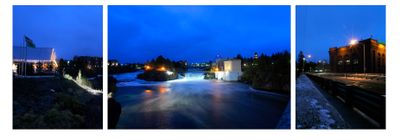Decades of human tinkering have shrunk, swollen and shifted river

There’s a story about Spokane Falls that Bill Youngs likes to tell.
Expo ’74 promoters were trying to persuade Ford and General Motors Co. to sponsor big exhibits at the World’s Fair, so they invited company officials to Spokane. During a fancy lunch at what is now Anthony’s, one of the Expo promoters casually asked, “Oh, have you seen our waterfalls?”
At precisely 12:35 p.m., the group moved to the window, where impressed auto officials watched the Spokane River thundering through downtown. The high flows at the height of summer weren’t natural. Avista Corp. had briefly unleashed stored water to help the fair effort.
Youngs, an Eastern Washington University history professor, tells the story to make a point. Spokane’s signature falls have a long history of human tinkering.
Last week, Avista agreed to release more water over the falls during the summer, staving off a Sierra Club lawsuit. The pact is the latest twist in the tale of a highly manipulated river.
The engineered releases will result in a more attractive cascade. Avista will forfeit a small amount of electrical generation as a result of the additional water flowing over the falls.
Youngs applauds the accord. Had the dispute gone to trial, he would have testified for the Sierra Club.
“It’s a tough issue sometimes, balancing beauty and utility,” said Youngs, author of “The Fair and the Falls,” which tracks the Spokane River’s industrialization and Expo ’74’s later focus on reclaiming the downtown river corridor for public enjoyment.
“The falls help generate power, which we all use,” Youngs said. “At the same time, we all benefit from beauty and the natural environment.”
For the Sierra Club, the issue went beyond aesthetics, said Rachael Paschal Osborn, director of the organization’s Spokane River Project.
“It’s the restoration of a place that’s very significant,” she said. “We do know that the falls were a gathering place for the tribes, and there were major salmon fisheries. James Glover and others settled here because of the falls. The whites looked at them with a much more utilitarian perspective, but they were here because of the falling water.”
Glover, known as the “Father of Spokane,” wrote rapturous descriptions about his first sighting of Spokane Falls in 1873. But he also was a real estate speculator. Within 20 years, sawmills, flour mills and dams were drawing power from the falls, which drop more than 100 feet through downtown.
“It’s hard to say what the falls really looked like,” said Bruce Howard, Avista’s director of environmental affairs.
Even the river’s original channel is something of a guess. After the Great Fire of 1889 destroyed downtown, one of the river’s side channels was filled in with debris from razed buildings. As the city rebuilt around it, the river narrowed.
Avista’s dams were part of the alterations. By 1889, the company’s Monroe Street Dam was operating. It was the first of six Avista dams on the Spokane River.
The utility generates about 10 percent of its electricity from the Spokane River. Energy from the Monroe Street and Upper Falls Dams flows directly to the Post Street substation, which supplies downtown.
“This is renewable energy,” Howard said. “We needed to operate the dams through the summer.”
Avista officials said they recognized the community’s desire for aesthetic flows over the falls five years ago, as the utility began working through the federal relicensing of its Spokane River dams. The dispute with the Sierra Club was over how much water to spill, and when.
Both sides got something out of the final agreement, the parties said.
Avista will redistribute the river’s flow, so that at least 300 cubic feet of water per second runs through Upper Falls’ north channel during the summer. That’s 2,250 gallons of water tumbling over the falls each second. After dark, the spill drops to 100 cubic feet of water per second.
The accord also stipulates that Upper Falls Dam will receive 500 cubic feet of water per second.
As part of the accord, Avista will also boost the flows in the lower falls and plug trenches cut into the river’s basalt foundation over the past century. The trench work will make the falls look fuller, said Speed Fitzhugh, Avista’s Spokane River license manager.
The parties expect the agreement to go into effect in 2011. Over the next two summers, Avista will upgrade electrical units in Upper Falls Dam’s powerhouse and complete the trench work.
“These are going to be nice cascades,” Howard said. But the summer flows won’t mimic the torrents of water associated with spring runoff, he cautioned. And they won’t roar like the short-lived display that helped woo both Ford and General Motors to Expo ’74.
“They’ll reflect the seasonality of precipitation in the Northwest,” Howard said.